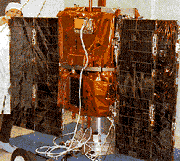SAMPEX
Solar Anomalous and Magnetospheric Particle Explorer
Part of the Small Explorer (SMEX) program
 SAMPEX is the first of NASA's Small Explorer (SMEX) missions. SAMPEX is designed to study the energy, composition and charge states of four classes of charged particles that originate beyond the Earth: (1) galactic cosmic rays (from supernova explosions in our Galaxy); (2) anomalous cosmic rays (from the interstellar gas surrounding our solar system); (3) solar energetic particles (from explosions in the solar atmosphere); and (4) magnetospheric electrons (particles from the solar wind trapped by the Earth's magnetic field). SAMPEX observations will provide important new information on the cosmic abundances of elements and their isotopes, the composition of local interstellar gas, the solar composition and the mechanisms responsible for solar atmospheric heating, and electron energy injection into the Earth's upper atmosphere.
SAMPEX is the first of NASA's Small Explorer (SMEX) missions. SAMPEX is designed to study the energy, composition and charge states of four classes of charged particles that originate beyond the Earth: (1) galactic cosmic rays (from supernova explosions in our Galaxy); (2) anomalous cosmic rays (from the interstellar gas surrounding our solar system); (3) solar energetic particles (from explosions in the solar atmosphere); and (4) magnetospheric electrons (particles from the solar wind trapped by the Earth's magnetic field). SAMPEX observations will provide important new information on the cosmic abundances of elements and their isotopes, the composition of local interstellar gas, the solar composition and the mechanisms responsible for solar atmospheric heating, and electron energy injection into the Earth's upper atmosphere.
Spacecraft
Single string architecture. Momentum-bias control system with 1 momentum wheel
and 3 torque rods for vehicle pointing. Attitude knowledge better than 2 deg (3 sigma). Attitude sensing via sun sensors, star sensors, magnetometer. 2 deployable, articulated solar panels with GaAs cells provide 102 W orbit average power (no eclipse). One 9 A-hr NiCd battery. Aluminum structure. Passive thermal control. Two omni antennas and near-Earth 5W S-band transponder. Solid-state memory. Fiber optic data bus (Mil-Std 1773).
Payload
SAMPEX carries 4 instruments. HILT (Heavy Ion Large Area Proportional Counter
Telescope) measures heavy ions from 8 to 220 MeV/nucleon for oxygen. LEICA (Low Energy Ion Composition Analyzer) measures 0.5 to 5 MeV for solar and magnetospheric ions. LEICA and HILT were originally designed and constructed as Get-Away-Specials for for shuttle flight. MAST (Mass Spectrometer Telescope) measures isotropic composition of elements from Li to Ni in the range of 10 MeV to several hundred MeV. PET (Proton/Electron Telescope) complements MAST by measuring the energy spectra and relative composition of protons (18 to 250 MeV) and helium nuclei (18 to 350 MeV/nuclei) of solar, interplanetary, and galactic origins, and the energy spectra of solar flare and precipitating electrons from 0.4 to 30 MeV.
| Country of Origin | United States |
| Customer/User | NASA |
| Manufacturer(s) | NASA Goddard Space Flight Center |
| Size | 1.5 m tall x 0.86 m dia. (stowed) |
| Orbit | 520 x 670 km, 82 deg inclination |
| Design Life | 1 year, 3 year goal |
| Related Sites | SAMPEX Home Page at GSFC |
Launch Facts
| Name | Int'l Desig. | Date | Site | Vehicle | Orbit | Mass(kg) |
| Notes | ||||||
| SAMPEX | 1992-038A | 7/3/92 | WSMC | Scout G1 | LEO | 158 |
| 1st Small Explorer mission; Solar Anomalous and Magnetospheric Particle Explorer | ||||||
Information in The Mission and Spacecraft Library is provided without warranty or guarantee. USE AT YOUR OWN RISK.